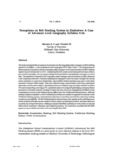Please use this identifier to cite or link to this item:
https://cris.library.msu.ac.zw//handle/11408/628| Title: | Perceptions on belt marking system in Zimbabwe: a case of Advanced Level Geography Syllabus 9156. | Authors: | Marimo, Simon T. Dzimiri, Wonderful |
Keywords: | Examination marking, belt marking system Traditional marking system, public examinations. |
Issue Date: | 2013 | Publisher: | Midlands State University | Series/Report no.: | The Dyke;Vol. 7, No. 1; p.71-84 | Abstract: | The study investigated the perceptions of examiners and the Geography subject managers on Belt Marking System in Zimbabwe: A Case of Advanced Level Geography (9156 Paper 1 and 2). The study focused on the perceptions of examiners and the Geography subject manager on the implementation the Belt Marking System since its introduction in 2011. Underpinned by both constructivist and positivist views within a post-positivist paradigm, the case study employed both quantitative and qualitative techniques to collect data. The population comprised of the Geography subject manager and one hundred and fifty Advanced Level Geography examiners. Purposive sampling was employed to select the subject manager and twenty senior examiners or supervisors (leadership), and stratified random sampling was used to select forty examiners to be part of the sample. Data were collected using a questionnaire, interviews, participant observation and document analysis. Quantitative data were analysed using descriptive statistics (numbers (N) and corresponding percentages (%). Qualitative data were analysed by identifying emerging themes and pattern in the data collected. Findings revealed that team structures employed by Zimbabwe School Examinations Council in Belt Making System differed from the Traditional Marking System. With belt marking method a candidate’s script is marked by more than one examiner as opposed one examiner in the Traditional Marking System, and moderation takes place at more than one level thus enhancing marking consistency and reliability. The Belt Marking System enhanced team work, speeded up the marking process, checks the speed of the fast and slow markers, reduces chances of cheating by markers, and keeps examiners on task by its conveyor belt nature. Challenges included that BMS was heavy in terms of time on task, left little room for examiners’ relaxation, and confined examiners. The researchers concluded that the BMS system is a more reliable innovation with more benefits than TMS. | URI: | http://hdl.handle.net/11408/628 | ISSN: | 1815-9036 |
| Appears in Collections: | Research Papers |
Show full item record
Items in MSUIR are protected by copyright, with all rights reserved, unless otherwise indicated.




